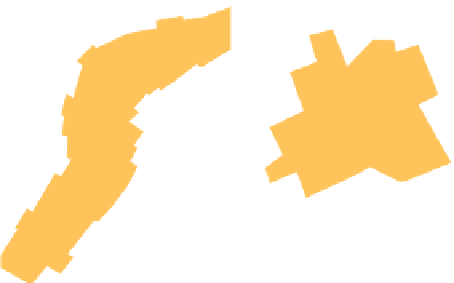Geography Reference
In-Depth Information
A
B
C
LINEAR VILLAGE
CLUSTER VILLAGE
ROUND VILLAGE
D
E
VILLAGE FORMS
Dwelling, Barn
Road
Field Boundary
Figure 11.13
Village Forms.
Five different repre-
sentative village layouts are shown here.
Adapted with permission from: J. E. Spencer and
W. H. Thomas,
Introducing Cultural Geography.
New
York: John Wiley & Sons, Inc., 1978, p. 154.
Garden
Farmland
WALLED VILLAGE
GRID VILLAGE
(Modified from Spencer & Thomas, 1978)
an old castle sits atop the hill, so in earlier times the site
offered protection as well as land conservation. In many
low-lying areas of western Europe, villages are located on
dikes and levees, so that they often take on linear charac-
teristics (Fig. 11.13A). Villages oriented along roads also
have this characteristic. Where there is space, a house and
outbuildings may be surrounded by a small garden; the
farms and pasturelands lie just beyond. In other cases,
a village may take on the characteristics of a cluster
(Fig. 11.13B). It may have begun as a small hamlet at the
intersection of two roads and then developed by accre-
tion. The European version of the East African circular
village, with its central cattle corral, is the round village or
rundling
(Fig. 11.13C). This layout was fi rst used by Slavic
farmer-herdsmen in eastern Europe and was later modi-
fi ed by Germanic settlers.
In many parts of the world, farm villages were forti-
fi ed to protect their inhabitants against marauders. Ten
thousand years ago, the fi rst farmers in the Fertile
Crescent faced attacks from the horsemen of Asia's steppes
and clustered together to ward off this danger. In Nigeria's
Yorubaland, the farmers would go out into the surround-
ing fi elds by day but retreat to the protection of walled
villages at night. Villages, as well as larger towns and cities
in Europe, were frequently walled and surrounded by
moats. When the population became so large that people
had to build houses outside the original wall, a new wall
would be built to protect them as well.
Walled villages
(Fig. 11.13D) still exist in rural areas of many countries—
reminders of a turbulent past.
More modern villages, notably planned rural settle-
ments, may be arranged on a grid pattern (Fig. 11.13E).
Grid patterns are not, however, a twentieth-century
invention. Centuries ago the Spanish invaders of Middle
America laid out
grid villages
and towns, as did other colo-
nial powers elsewhere in the world. In urban Africa, such
imprints of colonization are pervasive.
Although the twentieth century has witnessed unprec-
edented urban growth throughout the world, half of the
world's people still reside in villages and rural areas. As total
world population increases, total population in rural areas
is increasing in many parts of the world (even though the
proportion of the total population in rural areas may be
stagnant or declining). In China alone, approximately 50
percent of the more than 1.3 billion people live in rural
areas. In India, with a population over 1 billion, about 70
percent of the people live in places the government defi nes
as nonurban. Small rural settlements are home to most of
the inhabitants of Indonesia, Bangladesh, Pakistan, and
other countries of the global economic periphery, includ-
ing those in Africa. The agrarian village remains one of the
most common forms of settlement on Earth.
In some places, rural villages have changed as the
global economy has changed. For example, Mexico has
experienced rapid economic change since passage of the
North American Free Trade Act (NAFTA) in 1992. Along
























































































































































































































































































































